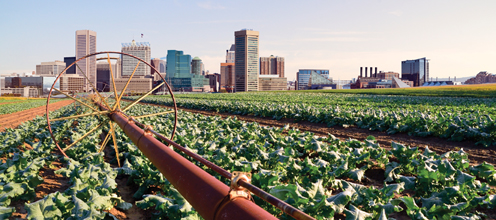Welcome to Blue Book!
Are you ready to join the thousands of companies who rely on Blue Book to drive smarter decisions? View our plans and get started today!
Still have questions? We’d love to show you what Blue Book can do for you. Drop us a line– we’ve been waiting for you.

Which trends and growing concerns are affecting Maryland and the Mid-Atlantic region? Many outside the industry would be surprised that agriculture is the largest industry for both Maryland and neighboring Virginia, employing 350,000 people in the first and 311,000 in the latter. As of 2014, nearly a third of each state’s land was used for farming, and though the nearby District of Columbia has no cropland of its own, it reaps the benefits of Maryland and Virginia’s agricultural bounty.
To start, Maryland’s leading commodities by value are watermelon, spinach, and cucumbers while Virginia’s top crops include tomatoes, apples, potatoes, and grapes. Both states ship to the Maryland Wholesale Produce Market, an outpost of the greater East Coast’s fresh produce industry.
The Jessup Market
The Maryland Wholesale Produce Market, more commonly known as the Jessup Market, leases space to 30 tenants involved in wholesale produce distribution. It is a geographically strategic hub along Routes 1 and 175 and a train line, putting receivers less than 20 minutes away from the Washington International Airport and the Port of Baltimore. Its location in Jessup also marks the midway point between Baltimore and Washington, DC.
The market plays a vital role in providing fresh fruit and vegetables to the Mid-Atlantic and District of Colombia region, selling many types of produce, whether grown locally, nationally, or around the globe. The latter, featuring a number of specialty and ethnic foods, has continued to grow in popularity the past few years. “We’ve seen more movement in items previously considered Hispanic or Asian, which now have broader appeal,” confirms Tony Vitrano, president of the Tony Vitrano Company, based at the Jessup market.
This is backed up by the opening of a new 100,000-square foot distribution center in Manassas, VA by Diaz Foods to supply the local Virginia, DC, and Maryland areas with Hispanic fruits and vegetables. Though Diaz Foods is headquartered in Atlanta, the new facility is expected to handle as much as $50 million in sales volume its first year.
Jerry Chadwick, vice president of sales, marketing, and business development at Lancaster Foods, LLC talked about ‘super greens’ and Clementines. Both items have surged in demand, he says, with the mandarins, a small easy-peel orange, shifting from a traditional five-pound box to a three-pound bag. Customers especially like bags with built-in handles, he notes, which allow for grab-and-go convenience and to buy a mix of product, instead of a single item.
Local Call
Local, seasonal produce contributes mightily to Maryland’s annual revenues, and the ‘Maryland’s Best’ branding program, run by the Maryland Department of Agriculture, is a driving force in getting the word out to suppliers and consumers. Agriculture secretary Joe Bartenfelder explains the initiative’s primary goal as connecting “Maryland farmers to new markets, and to brand Maryland-grown products so consumers can identify them, and hopefully, demand them.”




